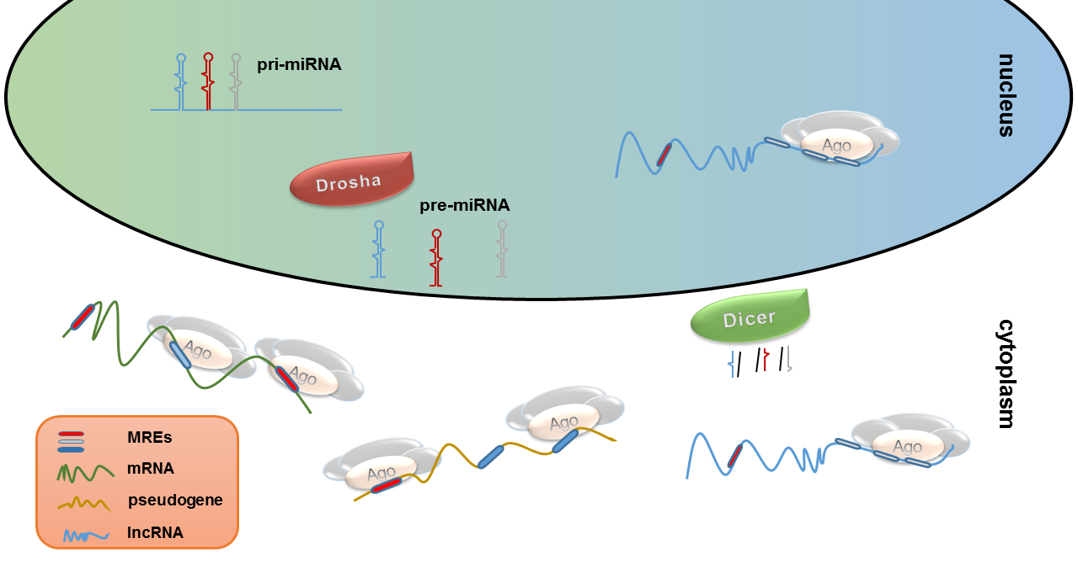MicroRNA research has revolutionized our understanding of gene regulation, fundamentally altering the landscape of molecular biology. Pioneered by Nobel laureates Gary Ruvkun and Victor Ambros, this innovative field emerged from their discovery in C. elegans, which later earned them the prestigious 2024 Nobel Prize in Physiology. With NIH funding supporting their groundbreaking work, microRNAs have gained attention for their potential in developing therapies for diseases such as cancer and Alzheimer’s. As the scientific community began to recognize the significance of these tiny molecules, interest surged, leading to clinical trials exploring their therapeutic applications. Through years of dedicated research, microRNAs have become recognized as crucial regulators of gene expression, establishing a vital link between gene function and health outcomes.
The exploration of small regulatory RNAs, often referred to as microRNAs, has ushered in a transformative era in biology and medicine. Initially overlooked, these molecules are now understood to play significant roles in managing gene expression and are critical to various cellular processes. Researchers like Gary Ruvkun, who pioneered early studies on microRNAs, have highlighted their implications for developing innovative medical therapies. With ongoing research funded by institutions like the NIH, the field continues to expand its reach, paving the way for potential advancements in treating complex diseases. As the scientific community delves deeper into the realm of RNA biology, the promise of microRNA-based therapies appears increasingly bright.
The Revolutionary Impact of microRNA Research
MicroRNA research has shifted the paradigm of gene regulation, particularly through the pioneering work of Nobel laureate Gary Ruvkun and his collaborator Victor Ambros. Their discovery in 1992 revealed that microRNAs act as crucial regulators of gene expression, a finding that initially went unnoticed by the broader scientific community. Despite the lack of immediate recognition, Ruvkun’s subsequent research highlighted the significant roles of these small RNA molecules in various biological processes. Today, microRNA therapies are emerging as promising treatments for diseases such as heart disease and cancer, showcasing the profound impact of their early research.
The implications of microRNA research extend far beyond C. elegans; they have been found to play essential roles in gene regulation across diverse organisms, including humans, plants, and other animals. Current studies indicate that the human genome contains approximately 1,000 distinct microRNAs, each intricately involved in moderating gene expression necessary for normal development and cellular function. The recognition of these tiny RNA molecules as vital players in the biological landscape exemplifies how foundational research can drive medical advancements and therapeutic discoveries.
Gary Ruvkun: A Journey from Underappreciation to Nobel Recognition
Gary Ruvkun’s path to receiving the Nobel Prize in physiology and medicine is a testament to perseverance and the gradual evolution of scientific understanding. Initially, both he and Ambros were met with skepticism from the scientific community regarding their discovery of microRNA, often perceived as a niche subject within the evolving fields of genetics and molecular biology. However, fueled by National Institutes of Health (NIH) grants, they continued to explore the intricacies of gene regulation, ultimately leading to greater recognition of their work in the years that followed.
Reflecting on his journey, Ruvkun expresses a sense of pride in how microRNA research has reshaped the landscape of genetics and medicine. What once seemed a modest discovery has now blossomed into a fundamental aspect of biological research, influencing areas such as developmental biology, cancer research, and genetic therapy. His experience highlights the importance of sustained funding and support for scientific inquiry, as transformative discoveries often arise from years of dedicated research and exploration.
The Role of NIH Funding in Advancing MicroRNA Research
The National Institutes of Health (NIH) has played a pivotal role in the advancement of microRNA research, providing essential funding that has allowed scientists like Gary Ruvkun to explore and elucidate the complex mechanisms of gene regulation. Over the years, federally funded research has contributed not only to significant scientific breakthroughs but also to the nurturing of new technologies and therapeutic approaches. Ruvkun’s laboratories, supported largely by NIH grants, have contributed impressive findings that have catalyzed further investigation into the potential of microRNAs in treating various diseases.
Funding from NIH has been instrumental in expanding the scope of research in molecular genetics. As Ruvkun notes, about three-quarters of his research has been federally funded, underscoring the critical role these grants play in sustaining scientific exploration. The impact of such funding extends beyond individual labs; it bolsters the entire biomedical research infrastructure, paving the way for the emergence of new pharmaceutical companies and biotech innovations derived from foundational discoveries in microbiology and gene regulation.
Emerging MicroRNA Therapies: Hope for Disease Treatment
The therapeutic potential of microRNAs has garnered substantial interest in recent years, with ongoing clinical trials aimed at leveraging these molecules to address serious health conditions such as heart disease, cancer, and neurodegenerative disorders. As researchers dive deeper into understanding the role of microRNAs in cellular pathways, innovative therapies are being developed that could radically change patient care. Companies focused on RNA interference therapeutics, like Alnylam, highlight the commercial and health implications of this research, marking a new horizon in medicine where gene regulation can be precisely targeted.
The progression from laboratory discovery to clinical application speaks volumes about the significance of microRNA research and the collaborative efforts within the scientific community. Clinical trials are increasingly focusing on utilizing microRNAs in targeted therapies, representing a shift toward personalized medicine where treatments are tailored to individual genetic profiles. As these therapies advance, they promise not only to improve treatment outcomes but also to expand our understanding of gene regulation and its influence on human health.
Federal Funding: The Bedrock of Scientific Innovation
Federal funding plays a critical role in nurturing scientific discovery, particularly in fields like microRNA research, where years of continuous investment are often required for breakthroughs. Ruvkun emphasizes that substantial support from NIH has been essential for his lab’s research endeavors, allowing for a sustained focus on the basic biology of microRNAs. Without such funding, many promising lines of inquiry could falter, hindering the progress of innovations that are vital for health and disease management.
Moreover, Ruvkun’s observations on the current climate of funding highlight a growing concern among researchers about the viability of scientific careers in the U.S. He warns that reduced federal investment might discourage talented individuals from pursuing paths in research, potentially leading to a brain drain where emerging scientists seek opportunities abroad. Thus, the legacy of microRNA research underlines the necessity for continued advocacy for federal support, essential for maintaining the scientific edge and fostering future generations of researchers.
The Evolution of Gene Regulation Understanding Through microRNA
The discovery of microRNA has revolutionized our understanding of gene regulation, illustrating the complexity and sophistication of biological systems at the molecular level. Initially, gene regulation was viewed through a limited lens, primarily focusing on transcription factors and promoters. However, the identification of microRNAs ushered in a new era, revealing an intricate network of regulatory mechanisms that extend far beyond classical gene expression models. These tiny molecules have emerged as key players in post-transcriptional regulation, significantly influencing gene activity.
As researchers continue to unravel the functions and mechanisms of microRNAs, their implications stretch into various fields, including developmental biology and cancer. The ability of microRNAs to modulate gene expression finely illustrates the delicate balance required for normal cellular processes, and their dysregulation often correlates with disease states. Thus, ongoing research and advancements in microRNA studies not only enhance our foundational knowledge but also open avenues for innovative therapeutic interventions.
MicroRNA’s Broader Implications Across Species
MicroRNA research transcends its origins in the C. elegans roundworm, illustrating a fundamental biological principle that applies across diverse taxa. Studies have shown that similar microRNA regulatory networks exist in plants, mammals, and other organisms, indicating that the insights gained from Ruvkun and Ambros’s work extend far beyond their initial model organism. This cross-species relevance enhances the importance of microRNA studies, as researchers can draw parallels between the regulatory roles of these molecules across evolutionary lines.
As the biological roles of microRNAs become better understood, researchers are increasingly recognizing their potential to inform agricultural advancements and biotechnology applications. Understanding how these small RNAs influence growth and development in various species can lead to improved crop varieties and novel strategies for pest resistance. Thus, the continued exploration of microRNAs not only sheds light on fundamental biological mechanisms but also promises to deliver practical benefits across ecological and economic contexts.
Challenges Facing the Future of MicroRNA Research
Despite the significant progress in microRNA research, several challenges lie ahead that could hinder further advancements in the field. One of the primary concerns is the potential reduction in federal funding, which Ruvkun warns could stifle innovation and deter young scientists from pursuing careers in research. As competition for grants becomes more intense, emerging researchers may find it increasingly difficult to secure the necessary financial support to explore novel hypotheses and develop groundbreaking therapies.
Additionally, the complexity of microRNA regulation presents a formidable challenge for researchers. The interplay between microRNAs and their target genes can be influenced by numerous environmental and genetic factors, complicating the understanding of their precise roles in health and disease. As such, future research will require not only insightful hypotheses but also meticulous experimental designs to unravel the complexities and fully capitalize on the therapeutic potential of microRNAs.
The Future of microRNA Technologies in Medicine
Looking ahead, the future of microRNA technologies holds immense promise for the development of innovative medical treatments. As researchers integrate cutting-edge techniques such as CRISPR and next-generation sequencing with microRNA studies, the potential for precision medicine expands significantly. Therapies specifically targeting microRNA pathways could lead to personalized interventions that enhance treatment efficacy while minimizing adverse effects, highlighting the need for ongoing research and exploration in this dynamic field.
Moreover, the growing understanding of microRNAs as biomarkers for various diseases foreshadows their role in diagnostics and prognosis. By identifying specific microRNA signatures associated with particular health conditions, clinicians can utilize these molecular indicators to make informed decisions regarding patient care. As knowledge in the field advances, the incorporation of microRNAs into therapeutic and diagnostic frameworks could significantly advance how we approach disease management in the 21st century.
Frequently Asked Questions
What is the role of microRNA in gene regulation according to Gary Ruvkun’s research?
Gary Ruvkun’s pioneering research on microRNA revealed that these small RNA molecules play a crucial role in gene regulation. They influence how genes are expressed and help control the translation of genes into proteins, which is essential for proper cellular function and development.
How did NIH funding influence advancements in microRNA research?
The significant contributions of NIH funding to microRNA research have propelled groundbreaking discoveries, including those made by Gary Ruvkun. These federal grants have supported extensive investigations into the functions of microRNA, facilitating the development of therapies for diseases like cancer and Alzheimer’s.
What therapeutic applications are being explored in microRNA research?
MicroRNA therapies are currently being investigated for their potential to treat various conditions, including heart disease, cancer, Crohn’s disease, and Alzheimer’s. These therapies aim to harness the regulatory power of microRNAs to restore normal gene function and combat disease.
How did microRNA discovery lead to a Nobel Prize for Gary Ruvkun?
The discovery of microRNA by Gary Ruvkun and Victor Ambros earned them the Nobel Prize in Physiology or Medicine in 2024, due to its transformative impact on our understanding of gene regulation and the subsequent developments in RNA-based therapies.
What is the significance of Gary Ruvkun’s findings on the human genome’s microRNA?
Gary Ruvkun’s research indicates that the human genome contains approximately 1,000 microRNAs, which regulate a majority of protein-producing genes. This discovery underscores the critical role of microRNAs in biological processes and highlights their importance in genetic research and medicine.
Can microRNA research lead to advancements in biotechnology and pharmaceuticals?
Yes, the advancements made in microRNA research have significantly influenced the biotechnology and pharmaceutical sectors. Companies such as Alnylam, which develops RNA interference therapeutics, exemplify how basic research in microRNA is driving innovation and breakthroughs in genetic disorder treatment.
What are the potential consequences of reduced funding for microRNA research?
Reduced funding for microRNA research could impede scientific progress, risking the loss of talented researchers to more stable career opportunities elsewhere. Gary Ruvkun emphasizes that ongoing investment is crucial for maintaining the U.S.’s leading position in scientific advancements and innovation.
How has the scientific community’s perception of microRNA research evolved since its discovery?
Since the initial discovery of microRNA, the scientific community’s perception has dramatically shifted, with increasing recognition of its significance across various fields, driven by robust research findings and the transformative potential of microRNA therapies.
| Key Points |
|---|
| Gary Ruvkun and Victor Ambros discovered microRNA in 1992. |
| Their work on gene regulation in C. elegans was initially met with skepticism. |
| MicroRNA research, mostly funded by NIH, attracted a niche community of RNA researchers. |
| Clinical trials for therapies based on microRNAs are ongoing for various diseases. |
| The human genome contains about 1,000 microRNAs that regulate protein-producing genes. |
| Ruvkun’s lab research has been significantly supported by federal funding. |
| Federal funding is critical for advancing fundamental scientific research. |
| Concerns exist about potential reductions in federal support for scientific research and its implications. |
Summary
MicroRNA research has transformed our understanding of genetic regulation and has become crucial to modern medicine. The pioneering work of Gary Ruvkun and Victor Ambros, which began seemingly unnoticed, now forms the foundation for innovative therapies addressing serious health conditions. With clinical trials advancing and growing interest from diverse scientific disciplines, the future of microRNA research looks promising. The critical funding from federal sources remains indispensable to maintain this scientific momentum and encourages the next generation of researchers, ensuring continued breakthroughs in medical science.



